This no-knead sourdough sandwich bread recipe has a soft crust, uses only wild yeast and doesn’t require any special equipment. Learn step-by-step how to feed a sourdough starter and make this easy recipe, perfect for beginners!
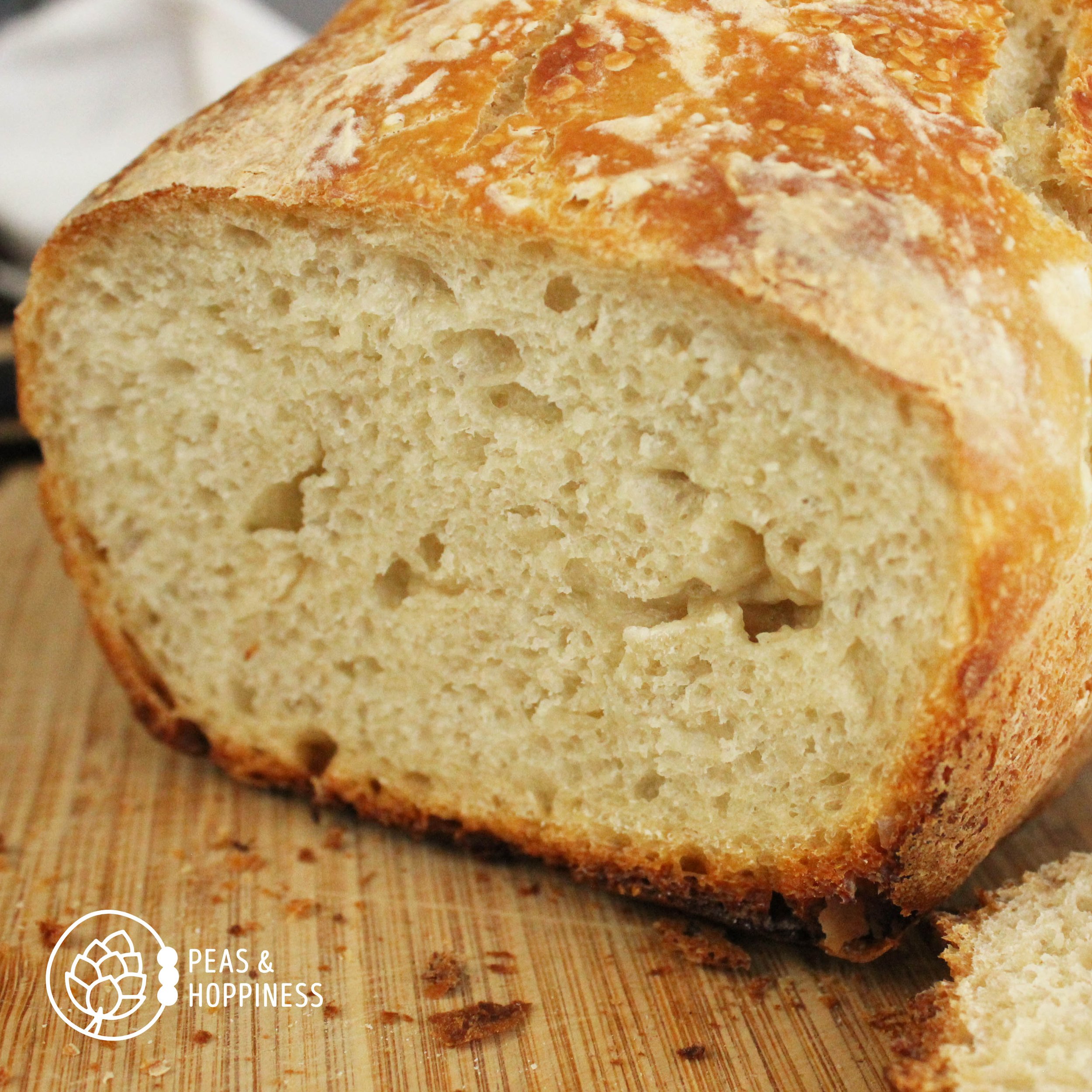 During the Covid-19 pandemic when we all found ourselves stuck indoors, sourdough bread-baking made a comeback in popularity. But sourdough bread is one of the oldest baking types in human history.
During the Covid-19 pandemic when we all found ourselves stuck indoors, sourdough bread-baking made a comeback in popularity. But sourdough bread is one of the oldest baking types in human history.
Commercial yeast — the kind you can buy in a packet in a store — didn’t exist until the 1860s and it was even later, in the 1940s, when yeast packets became ubiquitous in grocery stores.
Without yeast you buy in the store, you have two options: flatbreads such as naan, tortillas, or pita which are made without yeast or sourdough, which is leavened with natural yeast from the air.
Learn more about sourdough bread, how to maintain your sourdough starter, and find the easiest recipe to make sandwich sourdough bread you could imagine. It only uses four ingredients!.
What Gives Sourdough Bread its Distinct Sour Flavor?
Making sourdough bread takes a very long time – about 24 hours from start to finish – because wild yeast requires more time to ferment to allow the bread to rise. In contrast, commercial yeast is much more potent, meaning it can make the bread rise within just a few hours.
The slow fermentation process of sourdough is what makes it unique: during the process, the yeast produces acetic acid, which is what creates the distinct sour flavor.
How to Make Sourdough Bread: Start with a Sourdough Starter
In my kitchen, sourdough starts with my friend Merv.
Merv is my beloved sourdough starter who moved from Kansas City to Colorado with me. Over the years he’s multiplied and created more sourdough starter babies than I can count – such a fun gift to share!
Merv the Sourdough Starter is simply a mixture of equal parts water and flour (by weight) which natural yeast in the air has infiltrated to create a living organism.
If you need a sourdough starter you can create one from scratch by mixing water and flour together. Simply let this mixture sit on your counter and feed it twice a day until the yeast from the air turns it into a starter. I once tried this, but my starter met an untimely end after I failed to feed him often enough. Instead, it’s usually easier to find a friend with a starter who can share a bit or buy a starter online.
Merv the Sourdough Starter, Before and After Feeding
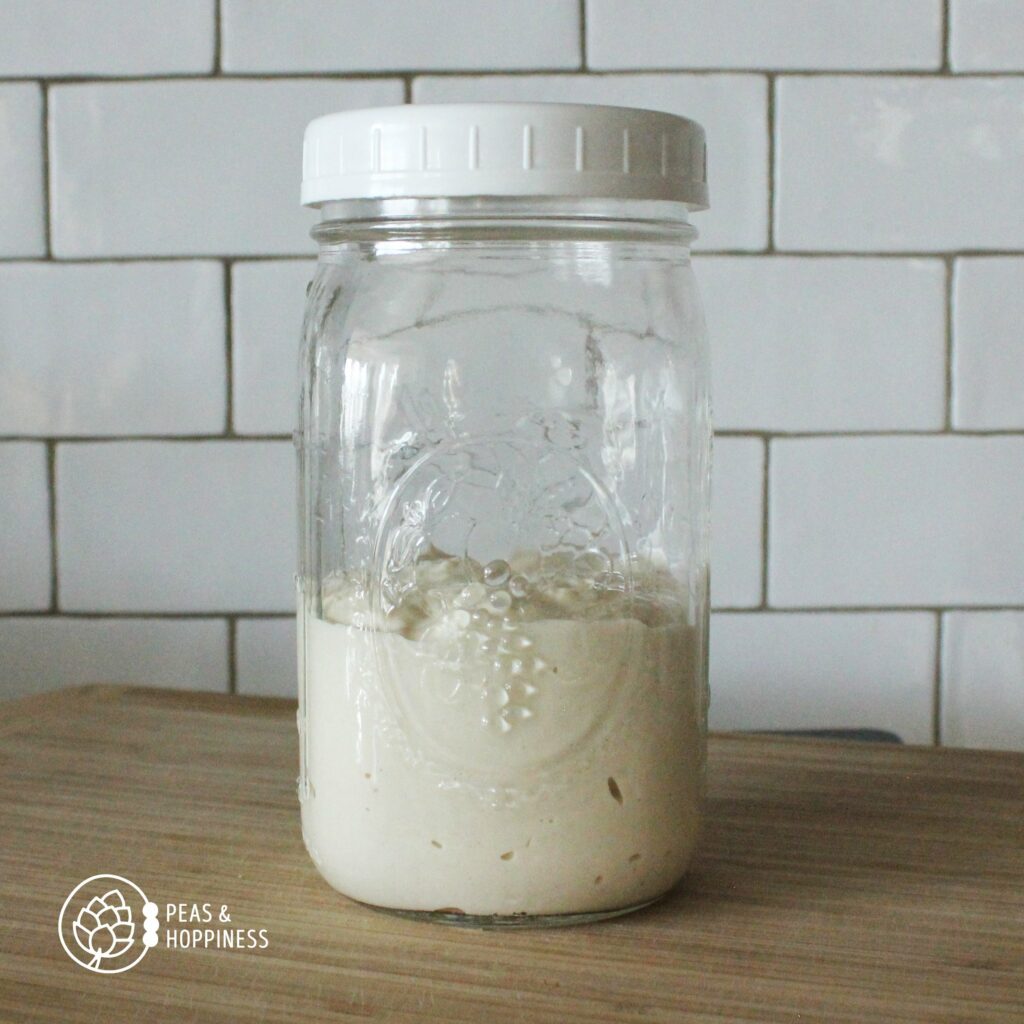
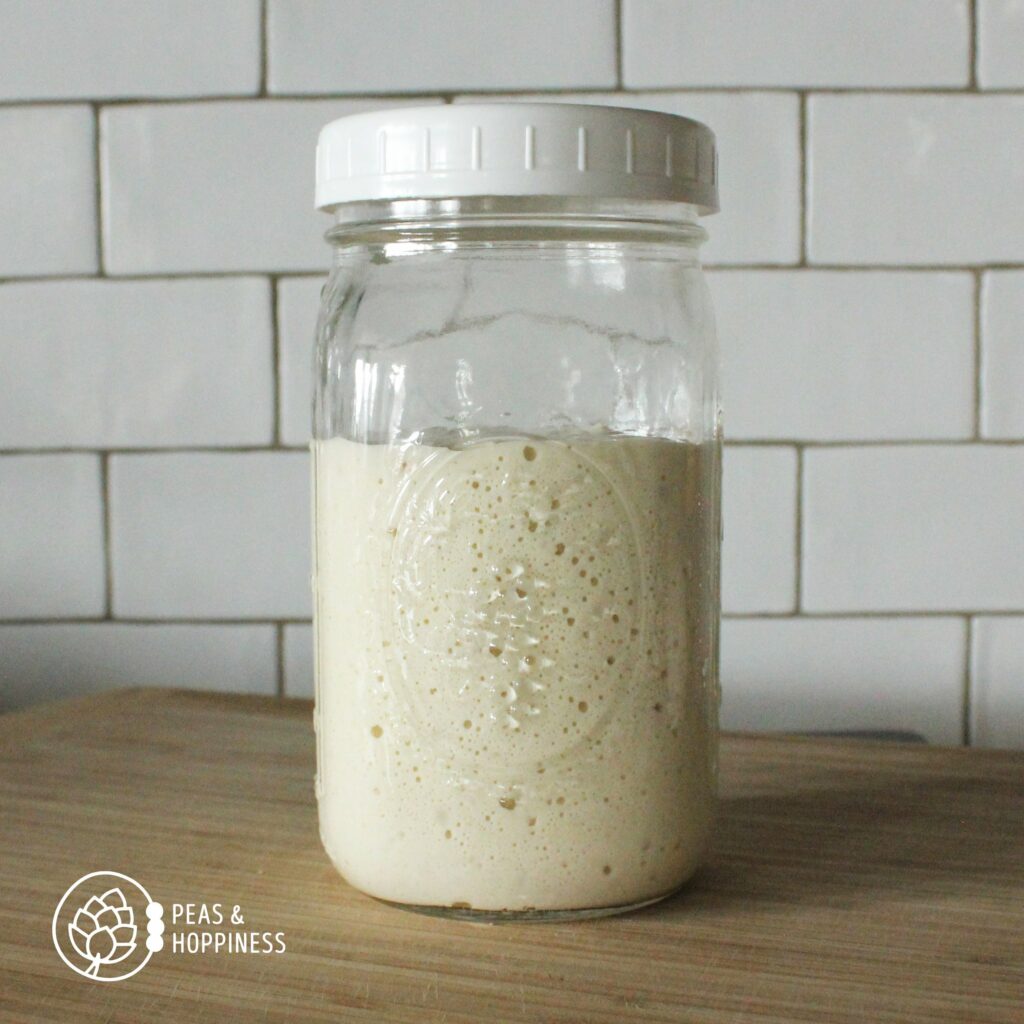
How do you Feed a Sourdough Starter?
Keeping your sourdough starter fed and healthy is essential to produce a quality loaf of sourdough bread. Never fear – it’s very easy to feed your starter!
The day before you plan to bake your sourdough bread, measure out equal parts water and flour by weight and add this to your starter. The amount of water and flour you add should be roughly equal to the amount of starter you have so it doubles in size.
I find it easiest to set my jar of sourdough starter on my kitchen scale and add flour directly to the jar, then zero the scale and add the same amount of water.
I then stir the starter well to incorporate all the new ingredients and let it sit at room temperature for several hours until I’m ready to mix up the dough for the bread.
If you don’t have a kitchen scale, the measurement is roughly a 1:2 ratio – meaning a half cup water for every one cup of flour.
What Type of Flour is Best to Use for a Sourdough Starter?
You can just just about any type of flour to feed your sourdough starter. I use unbleached white all-purpose flour because I prefer the simplicity of this flour – nothing gets in the way of the sour flavor when I bake the bread.
You can also use other types of glutenous flour, such as whole wheat, rye, or spelt. If you want to try something new, but nervous about how it might work, I suggest to split your starter into two containers and try two different types of flour. It’s fun to experiment!
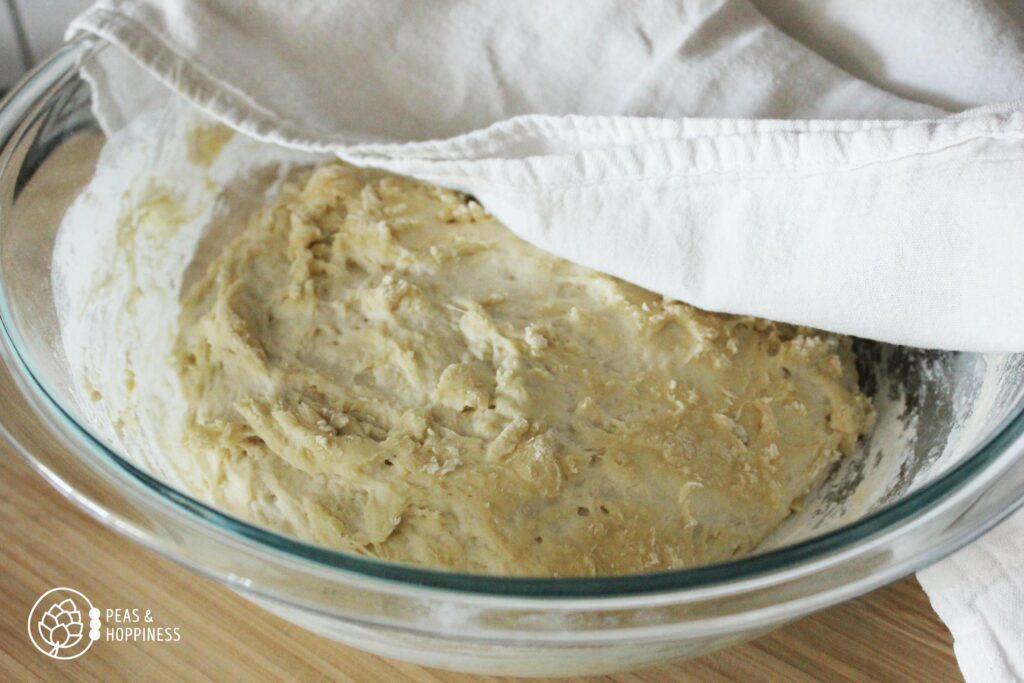
How Long can a Sourdough Starter go Between Feedings?
Lucky for me, sourdough starters are very hearty.
The more often you feed your starter, the healthier it will be. A healthy starter is better at leavening your bread and will yield a lighter, softer loaf. A starter who hasn’t been fed regularly will take longer to make the dough rise and will usually produce a denser loaf.
When I feed my starter about once per week, the sourdough loaves come out perfect.
However, I think my record is about two months between feedings, which happened after I had my son and was trying to keep up my small business and nurse a newborn. I’ve heard of others who have gone even longer than this, but I really don’t want to test the limits!
It’s possible to freeze your sourdough starter if you’re not going to be able to feed it for a long time – possibly up to 12 months! But keep in mind that sourdough starter contains living yeast and the longer it’s in the freezer, the more yeast will die.
If it’s been a while in between feedings, I recommend feeding your sourdough starter several days in a row before baking bread to ensure you have a healthy colony of yeast in the starter which is ready to help your bread rise.
What's the Easiest Way to Make Sourdough Bread?
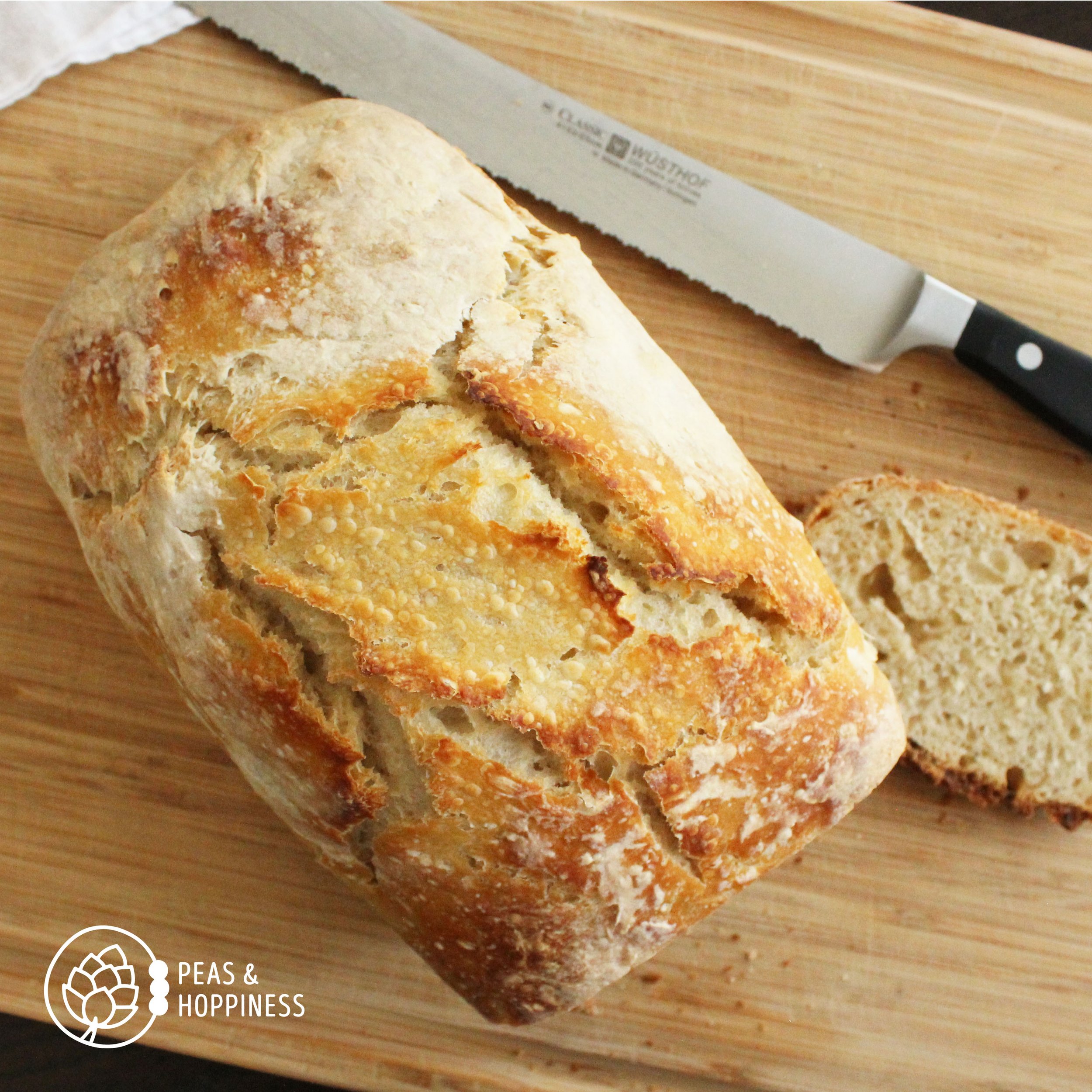 I’ve developed a sourdough bread recipe that is so easy. It requires NO kneading and NO special equipment. A typical bread loaf pan is all you need! No expensive Dutch Oven, no fancy proofing bowl, no specialty stick-shaped tools (I’m told they’re called “bread lames”).
I’ve developed a sourdough bread recipe that is so easy. It requires NO kneading and NO special equipment. A typical bread loaf pan is all you need! No expensive Dutch Oven, no fancy proofing bowl, no specialty stick-shaped tools (I’m told they’re called “bread lames”).
Side note: if you don’t have a bread loaf pan, you can buy one for less than $20, or you can follow this recipe for Easy Artisan Sourdough Bread, which requires kneading, but you can use any flat pan to bake it on.
Instead of complicated instructions or cooking equipment, over the years I’ve developed this EASY no-knead sourdough bread recipe.
This recipe is easy enough for anyone – even me, a self-proclaimed non-baker. My boxed brownies often fall flat, but this sourdough bread is one of my favorite things to make and bring to a dinner party.
This recipe yields a lovely loaf of sandwich bread, as opposed to the traditional thick crust on most sourdough loaves. (If you’re looking for an artisan sourdough recipe, you can find that here.)
Ingredients for Sourdough Sandwich Bread
This recipe is so simple! You literally only need FOUR ingredients to make this No-Knead Sourdough Sandwich Bread:
- 3 cup Unbleached all purpose flour
- 1 tsp Salt (add more salt for more sour taste)
- 3/4 cup Sourdough starter (fed within 24 hours of making bread)
- 1 1/2 cup Water
That’s it! You can play around with the type of flour you use for variety. Sometimes I like to use half whole wheat flour and half bread flour. The whole wheat flour provides more fiber, vitamins, and minerals. It’s helpful to use half bread flour when using some whole wheat to increase the amount of gluten so the bread isn’t too dense (read more about gluten).
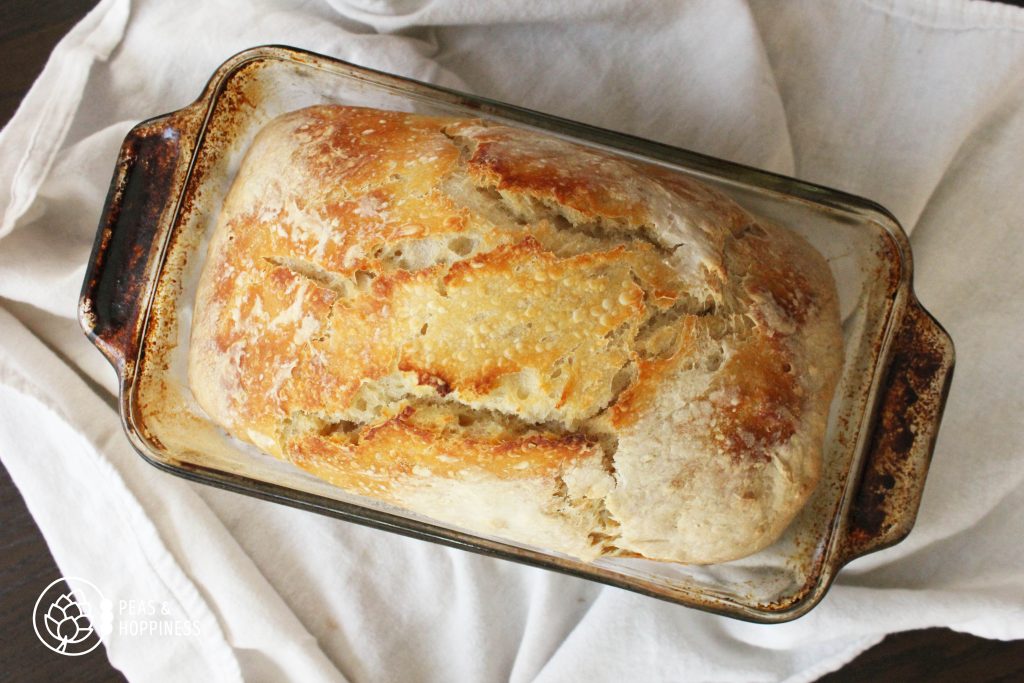
How to Make No-Knead Sourdough Sandwich Bread from Wild Yeast
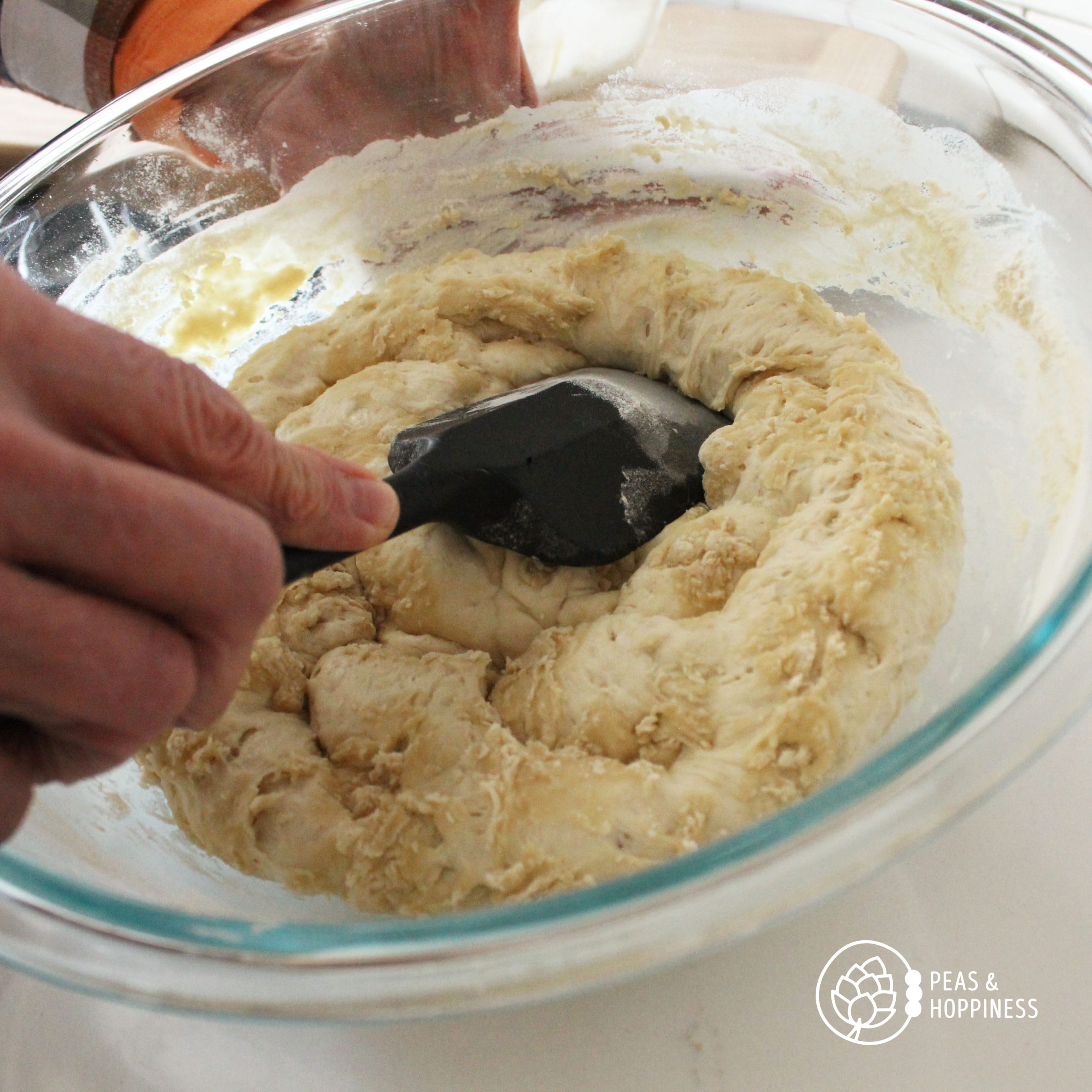 Making sourdough bread is an overnight process. I usually start the recipe in the evening, sometime after 7:00 pm the night before I plan to bake. The bread comes out of the oven around mid-afternoon the next day.
Making sourdough bread is an overnight process. I usually start the recipe in the evening, sometime after 7:00 pm the night before I plan to bake. The bread comes out of the oven around mid-afternoon the next day.
In a large bowl, stir together the flour and salt. If you prefer a more sour flavor, add extra salt, which will slow the fermentation process and allow more acetic acid to form.
Add the water and the fed sourdough starter directly to the flour and salt mixture. Use a large spoon to stir until well-mixed and a wet dough forms. No kneading required!
Cover the bowl with a towel and allow dough to rest in a warm place in your kitchen overnight. I recommend allowing the dough to sit at least 12 hours; in a colder kitchen it may need more time and in a warmer kitchen it might need less.
The next day the dough should have risen until it has more than doubled; if it begins to fall, it’s risen too long. Hurry on to the next step!
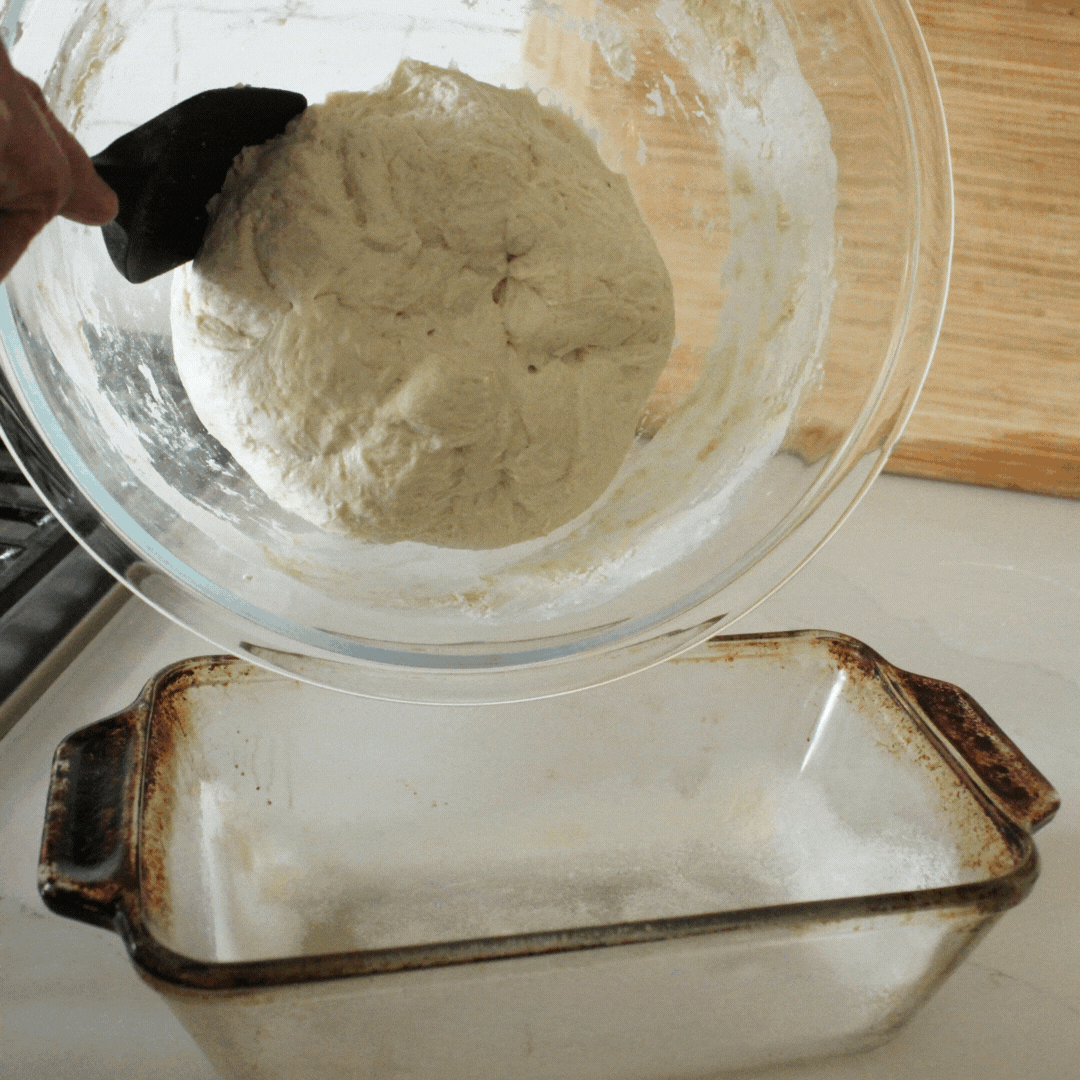
Prepare a loaf pan by greasing with oil or cooking spray, then coat with flour by sprinkling some in and patting the pan on all sides to distribute it.
Use a floured spatula or large spoon to pat the risen dough down, releasing all air bubbles. This step helps ensure an even texture for your bread. Transfer the dough directly from the bowl into the prepared baking pan. Cover the bread and allow to rise another 3-5 hours. The dough should double in size again but should not fall; if it’s fallen, it will still taste good but won’t be as pretty!
Once the dough has risen a second time, preheat the oven to 450 degrees Fahrenheit. Cover bread with foil and bake for 45 minutes. Remove foil and bake an additional 15 minutes. You’ll know the bread is done when it sounds hollow when you tap it. It should be slightly crusty on top and golden brown.
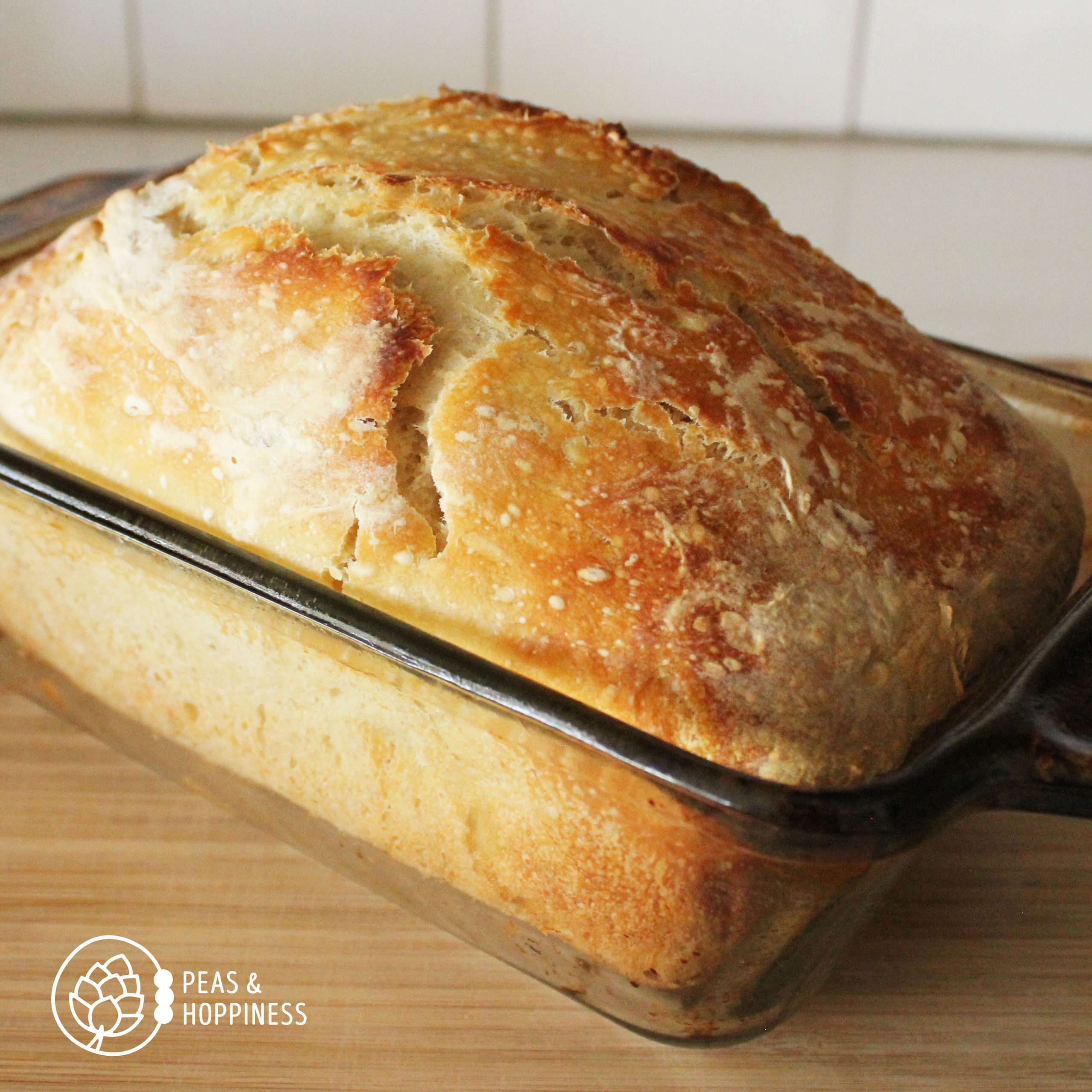 Look at that. Fresh, homemade, mouth-watering sourdough.
Look at that. Fresh, homemade, mouth-watering sourdough.
For other ways to use your sourdough starter, check out this recipe for Artisan Sourdough Bread or this one for Ooey-Gooey Sourdough Cinnamon Rolls.
Happy bread baking!
Dietitian Ann
Gather around the table with your family this week.
It all starts with a plan! Grab this Meal Planning Template and follow my easy 3-step process to create a meal plan that works with your busy schedule.
Enjoy the freedom of knowing what’s for dinner!
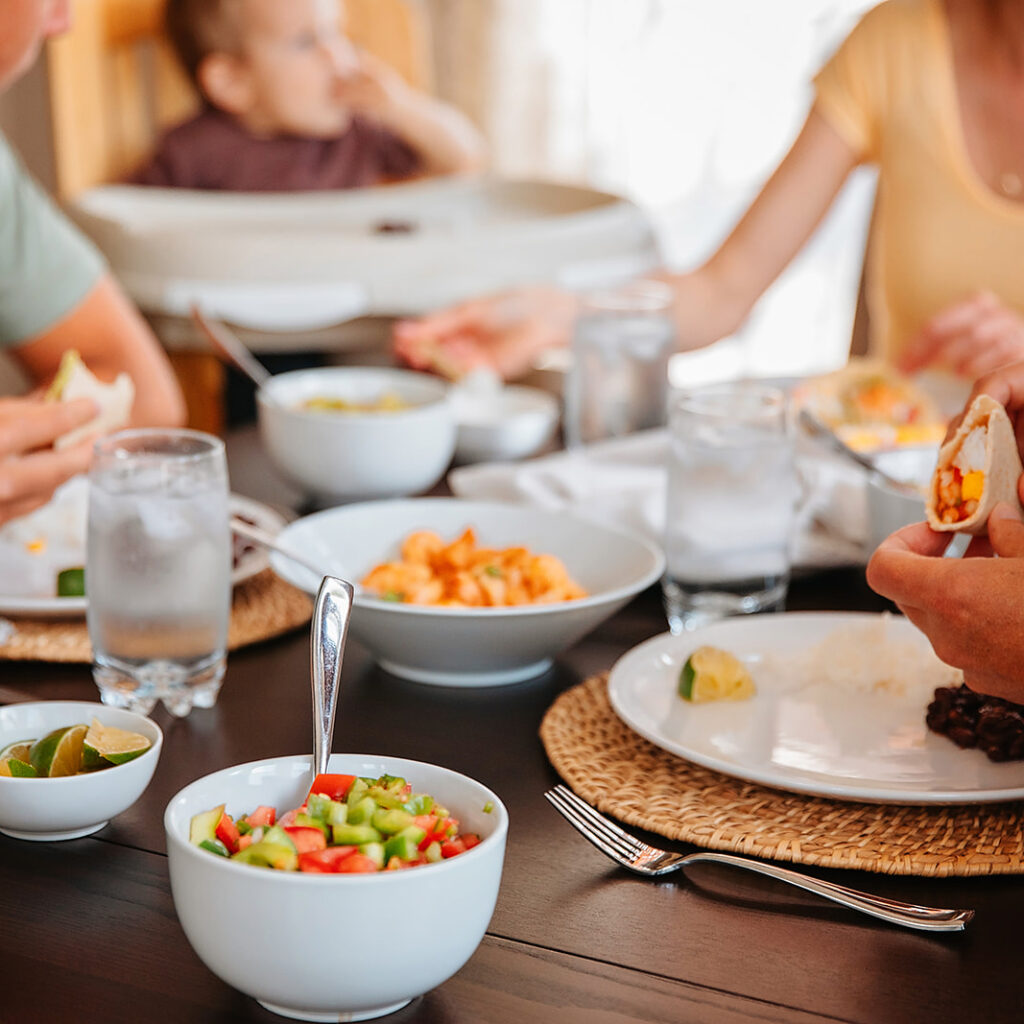
6 thoughts on “No-Knead Sourdough Sandwich Bread”
No crust? Gasp!
I know — I’m just not a good artisan baker like you. You make amazingly yummy crusty bread! But I’m making this more for an all-purpose bread we can eat all week long. So, really, this is like a sandwich bread that just happens to be leavened without commercial yeast rather than a traditional sourdough. Although it is nice and sour. 🙂
yum!!! I don’t think Mom ever made this kind of bread. Her bread (usually dinner rolls) came about more like "Hungry people are going to be here in an hour. Quick! Make some rolls! Never mind letting them rise twice, just hurry up and get food on the table" I was never sure how it happened, but somehow homemade bread was quick in her kitchen.
Haha! Yes, this bread definitely takes some forethought.
I bet to make the rolls rise so fast that Grandma used a different kind of leavening — probably some baking powder. More of a quickbread rather than a yeast bread? Although I do have a recipe for pizza crust that only takes about an hour to rise. Sometimes you can hurry the process along by letting the dough sit on top of a warm oven. The yeast like the warmer temperatures and will multiply faster, thus helping the bread to rise more quickly.
Why can’t you just dump the dough into the bread pan? What is the purpose of dumping it out onto the counter? Seems messier.
You actually can! I’ve updated the recipe with this – thank you for asking, it’s made my life a lot easier!